Study of Interference Detection of Rail Transit Wireless Communication System Based on Fourth-Order Cyclic Cumulant
Abstract
:1. Introduction
- Two FOCC-based interference detection algorithms are proposed for application in the train transit wireless communication scene, which is susceptible to both adjacent-frequency interference and same-frequency interference.
- The correct rate and computational complexity of the proposed algorithms are analyzed and compared with the traditional second-order statistical methods.
- The impact of multipath and Doppler on algorithm performance is analyzed through simulation tests.
- The advantages of the proposed algorithms include the following:
- (1)
- The FOCC of the received time-frequency overlapping signal is used as a feature for interference detection. Compared with the traditional second-order statistical properties, the anti-noise performance is better because it is 0 for the cyclic cumulant of white Gaussian noise to be larger than the second order. This is very useful in rail transit wireless communication applications because the background noise varies with the arrival and departure of trains.
- (2)
- Traditional time-domain energy detectors are only effective during quiet periods, i.e., they can only detect interference when expected signals are not present, and the detection performance largely depends on the accuracy of the noise estimation. However, in trail transit wireless communication scenarios, the interference signals usually coexist with the expected signal, and there are errors in estimating the noise variance. In this case, the energy detectors would no longer be applicable, and the proposed method in this paper has significant advantages over the existing one.
- (3)
- The traditional frequency-domain method can only detect adjacent-frequency interference. The proposed methods can detect both adjacent-frequency interference and same-frequency interference because the spectral power of the expected signal is considered to detect same-frequency interference.
- (4)
- In a rail transit wireless communication scenario, the multipath propagation and Doppler effect will lead to the performance degradation of interference detection algorithms. The proposed FOCC-based method can overcome the Doppler effect because its influence on the cyclic frequencies can be ignored. Although the proposed method is also affected by multipath propagation, it still works well at medium SNRs.
2. Signal Model
3. Algorithm Principle and Implementation
3.1. Fourth-Order Cyclic Cumulant
3.2. Detection Algorithm for the Adjacent-Frequency Interference
| Algorithm 1 FOCC-based Adjacent-Frequency Interference Detection Algorithm |
| (Step 1) The power of the received mixed signal x(t) is normalized, and the power spectrum is calculated to determine the search range of the cyclic frequency . (Step 2) The FOCC of x(t) is calculated, and its amplitude spectrum for cyclic frequencies is obtained. (Step 3) A suitable threshold is set to calculate the number of discrete spectral lines in the amplitude spectrum. In this paper, the threshold is set to 0.5 according to the analysis of Equation (7). (Step 4) The adjacent-frequency interference occurs when the number of discrete spectral lines is greater than the number of expected signals; otherwise, there is no adjacent-frequency interference. |
3.3. Detection Algorithm for the Same-Frequency Interference
3.4. Computational Complexity
4. Simulation Experiments and Result Analysis
- Experiment A. Correct rate of the adjacent-frequency interference detection algorithm
- Experiment B. Correct rate of the same-frequency interference detection algorithm
- Experiment C. Interference detection in multipath and Doppler environments
5. Conclusions
Author Contributions
Funding
Institutional Review Board Statement
Informed Consent Statement
Data Availability Statement
Conflicts of Interest
References
- Cheng, P.F.; Wang, H.Y.; Yang, G.J. Integration of digital economy and rail transportation industry: Realistic logic, path and countermeasures. Bus. Stud. 2022, 29, 84–97. [Google Scholar]
- He, J.H. Application of 800MHz wireless digital trunking communication system in Qinhuangdao port. Port Technol. 2015, 1, 33–36. [Google Scholar]
- Guan, M.D.; Liu, J.H.; Cai, B. 2.4 G and 5.8 G wireless communication systems used in subways. Railr. Commun. Signal Eng. Technol. 2008, 1, 37–39. [Google Scholar]
- Dai, K.P. Anti-interference research of LTE-M vehicle-ground wireless communication system. Railw. Commun. Signal 2017, 53, 47–50. [Google Scholar]
- Pochet, J.; Baro, S.; Sandou, G. Automatic train supervision for a CBTC suburban railway line using multi-objective optimization. In Proceedings of the 2017 IEEE 20th International Conference on Intelligent Transportation Systems (ITSC), Yokohama, Japan, 16–19 October 2017; pp. 1–6. [Google Scholar]
- Du, H.; Wen, C.; Li, W. A new method for detecting and early-warning in-band interference of the GSM-R network. In Proceedings of the 2017 IEEE 17th International Conference on Communication Technology (ICCT), Chengdu, China, 27–30 October 2017; pp. 800–804. [Google Scholar]
- Zhang, Z.; He, X.; Yuan, H. A robust parking detection algorithm against electric railway magnetic field interference. IEEE Trans. Intell. Transp. Syst. 2020, 21, 882–893. [Google Scholar] [CrossRef]
- Mohine, S.; Bansod, B.S.; Kumar, P. Time domain energy detector approach for detection of moving ground vehicle. In Proceedings of the 2019 IEEE 5th International Conference for Convergence in Technology (I2CT), Pune, India, 29–31 March 2019; pp. 1–4. [Google Scholar]
- Gismalla, E.H.; Alsusa, E. Performance analysis of the periodogram-based energy detector in fading channels. IEEE Trans. Signal Process. 2011, 59, 3712–3721. [Google Scholar] [CrossRef]
- Guo, H.; Jiang, W.; Luo, W. A modified energy detector for random signals in Gaussian noise. IEEE Commun. Lett. 2015, 19, 1358–1361. [Google Scholar] [CrossRef]
- Jin, E.S.; Park, H. A novel frequency domain preamble detection for OFDM based WLAN systems. In Proceedings of the 2020 International Conference on Information and Communication Technology Convergence (ICTC), Jeju Island, Republic of Korea, 21–23 October 2020; pp. 1494–1498. [Google Scholar]
- Henttu, P.; Aromaa, S. Consecutive mean excision algorithm. In Proceedings of the IEEE Seventh International Symposium on Spread Spectrum Techniques and Applications, Prague, Czech Republic, 2–5 September 2002; pp. 450–454. [Google Scholar]
- Vartiainen, J. Always one/zero malicious user detection in cooperative sensing using the FCME method. In Proceedings of the 2012 7th International ICST Conference on Cognitive Radio Oriented Wireless Networks and Communications (CROWNCOM), Stockholm, Sweden, 18–20 June 2012. [Google Scholar]
- Li, G.; Liu, N.; Zhang, C. Research and design of a transmission system for time-frequency-domain electromagnetic method. IEEE Access 2019, 7, 153999–154007. [Google Scholar] [CrossRef]
- Xing, L.; Wen, Y.; Thomas, D.W.P. A Joint time-frequency analytical method for electromagnetic interference in railway GNSS system. In Proceedings of the 2020 International Symposium on Electromagnetic Compatibility, EMC EUROPE, Rome, Italy, 23–25 September 2020; pp. 1–4. [Google Scholar]
- Yadav, S.K.; George, N.V. Coarray MUSIC-Group delay: High-resolution source localization using non-uniform arrays. IEEE Trans. Veh. Technol. 2021, 70, 9597–9601. [Google Scholar] [CrossRef]
- Zhang, Z.C. New Wigner distribution and ambiguity function based on the generalized translation in the linear canonical transform domain. Signal Process. 2016, 118, 51–61. [Google Scholar] [CrossRef]
- Mhiri; Korso, M.E.; Breloy, A. Multifrequency array calibration in presence of radio frequency interferences. Signal Process. Off. Publ. Eur. Assoc. Signal Process. (EURASIP) 2022, 199, 108613–108622. [Google Scholar]
- Huang, L.; Wu, S.; Li, X. Reduced-rank MDL method for source enumeration in high-resolution array processing. IEEE Trans. Signal Process. 2007, 55, 5658–5667. [Google Scholar] [CrossRef]
- Fernández-Menduiña, S.; Krahmer, K.; Leus, G. Computational array signal processing via modulo non-linearities. IEEE Trans. Signal Process. 2022, 70, 2168–2179. [Google Scholar] [CrossRef]
- Liu, M.Q. Research on Key Technologies for Signal Detection and Modulation Identification in Non-Cooperative Communication. Ph.D. Thesis, Xidian University, Xi’an, China, 2013. [Google Scholar]
- Zhang, L.H.; Qiu, T.S.; Li, J.C. A blind source separation method based on fourth-order cyclic cumulant. Signal Process. 2011, 27, 1412–1415. [Google Scholar]
- Zhan, Y.; Zeng, G.; Duan, C. A high order statistics based multipath interference detection method. IET Commun. 2021, 15, 1586–1596. [Google Scholar] [CrossRef]
- Sun, C.Q.; Liu, K.; Wang, P.Q. Blind frequency offset estimation algorithm for the same-frequency 16QAM signal based on higher-order cumulants. Electron. Meas. Technol. 2019, 42, 85–90. [Google Scholar]
- Bao, C.F. Research on Doppler Frequency Shift Estimation Algorithm for High-Speed Railroad Wireless Communication System. Master’s Thesis, Lanzhou Jiaotong University, Lanzhou, China, 2014. [Google Scholar]
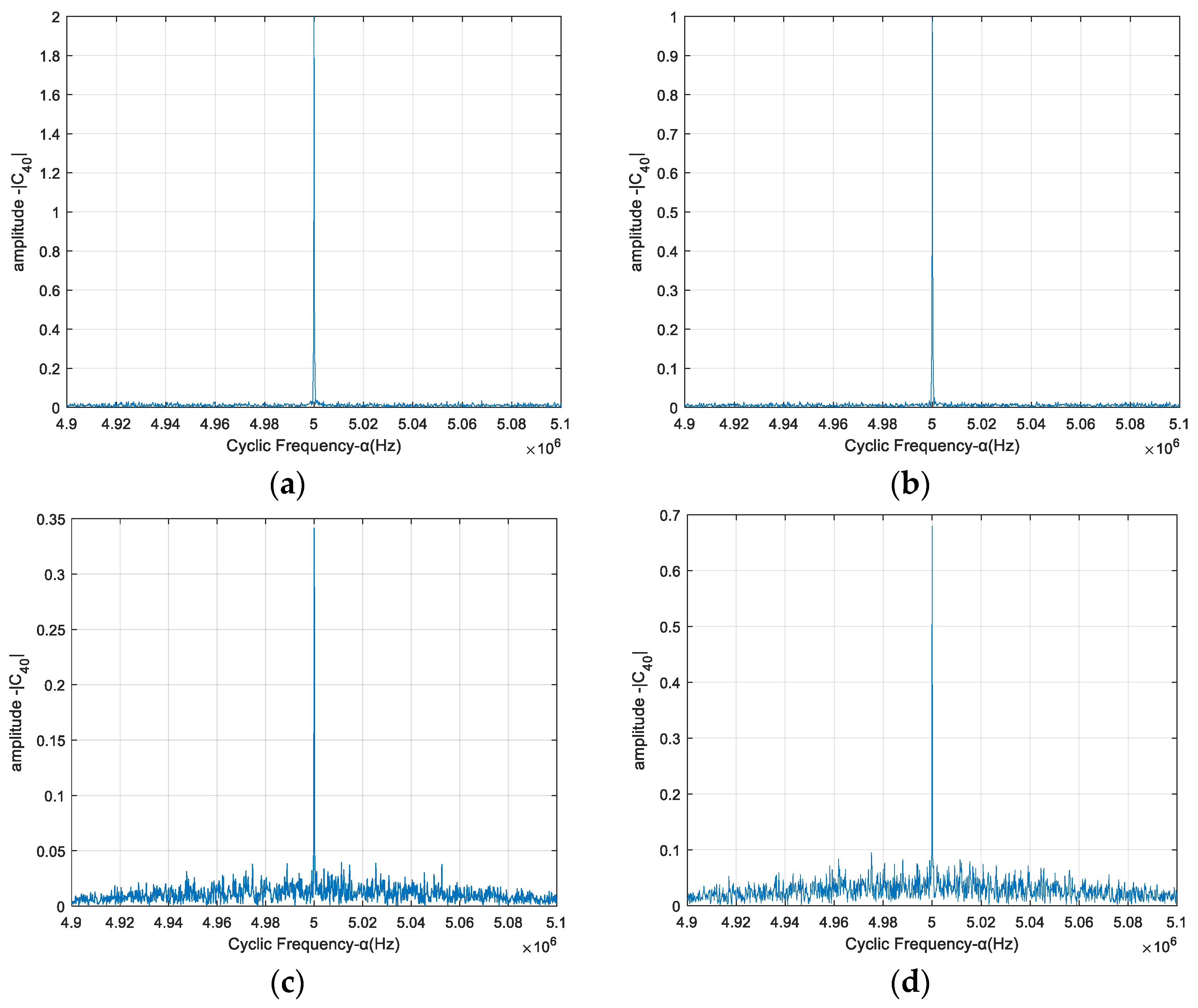
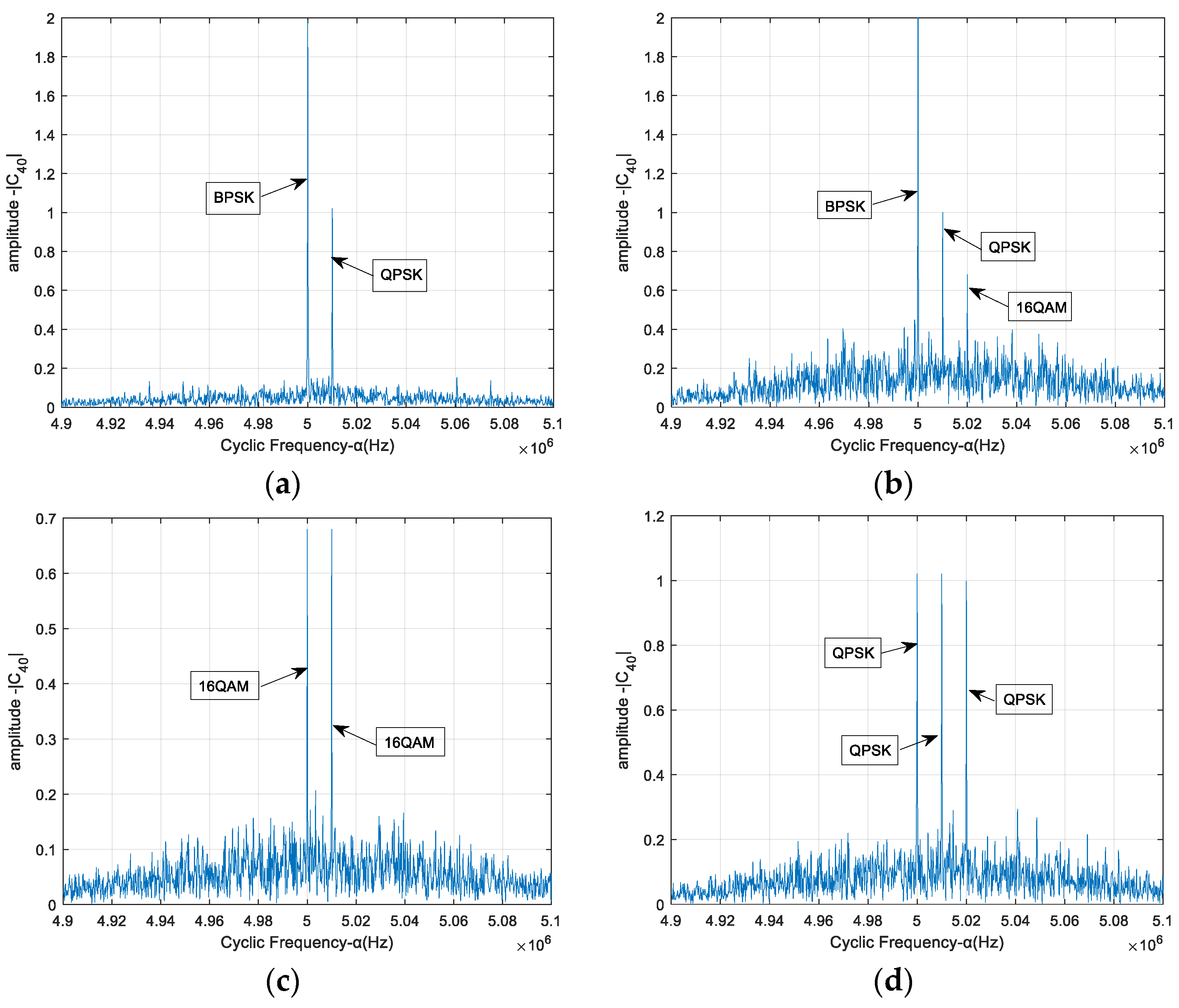
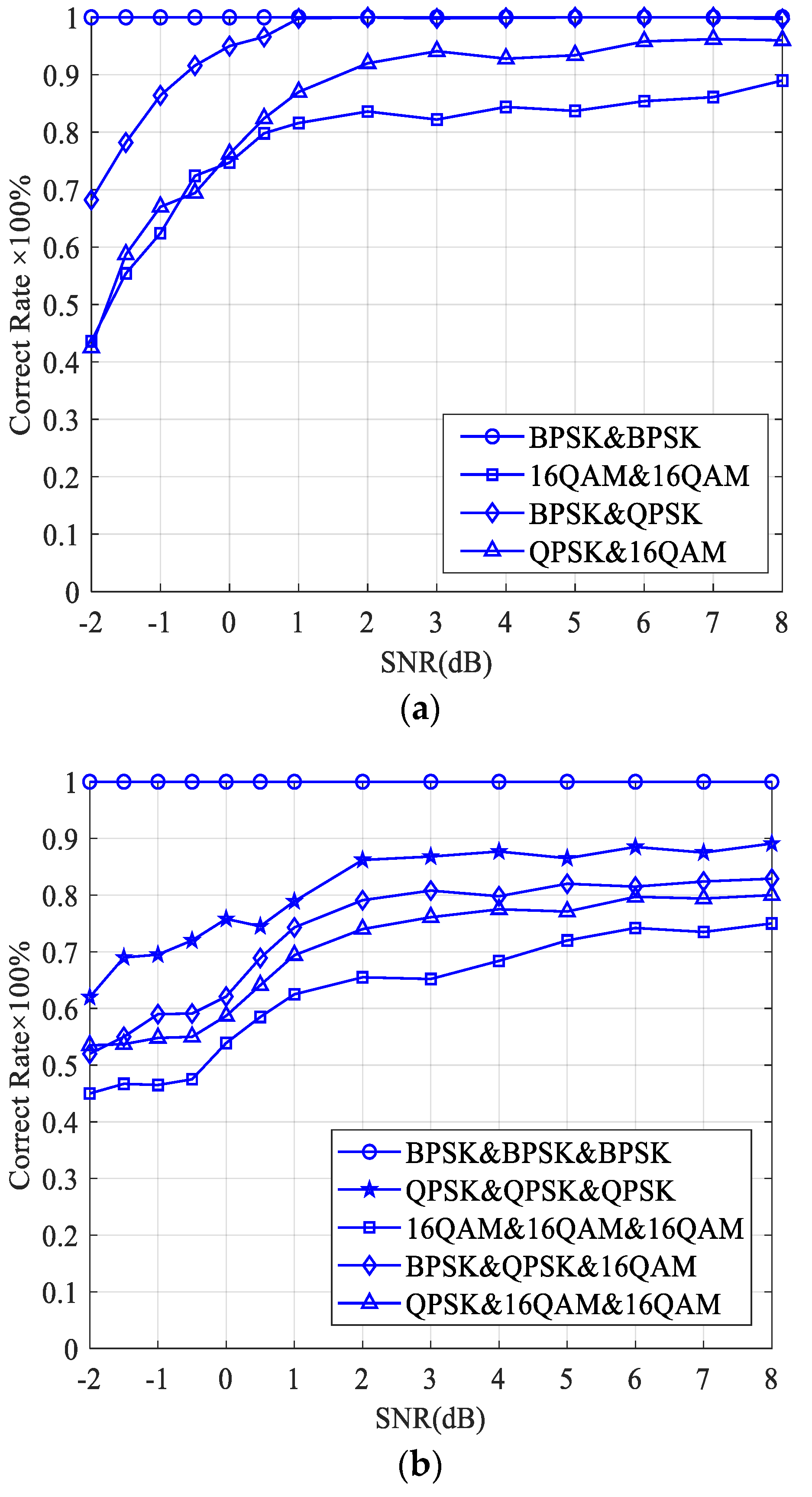
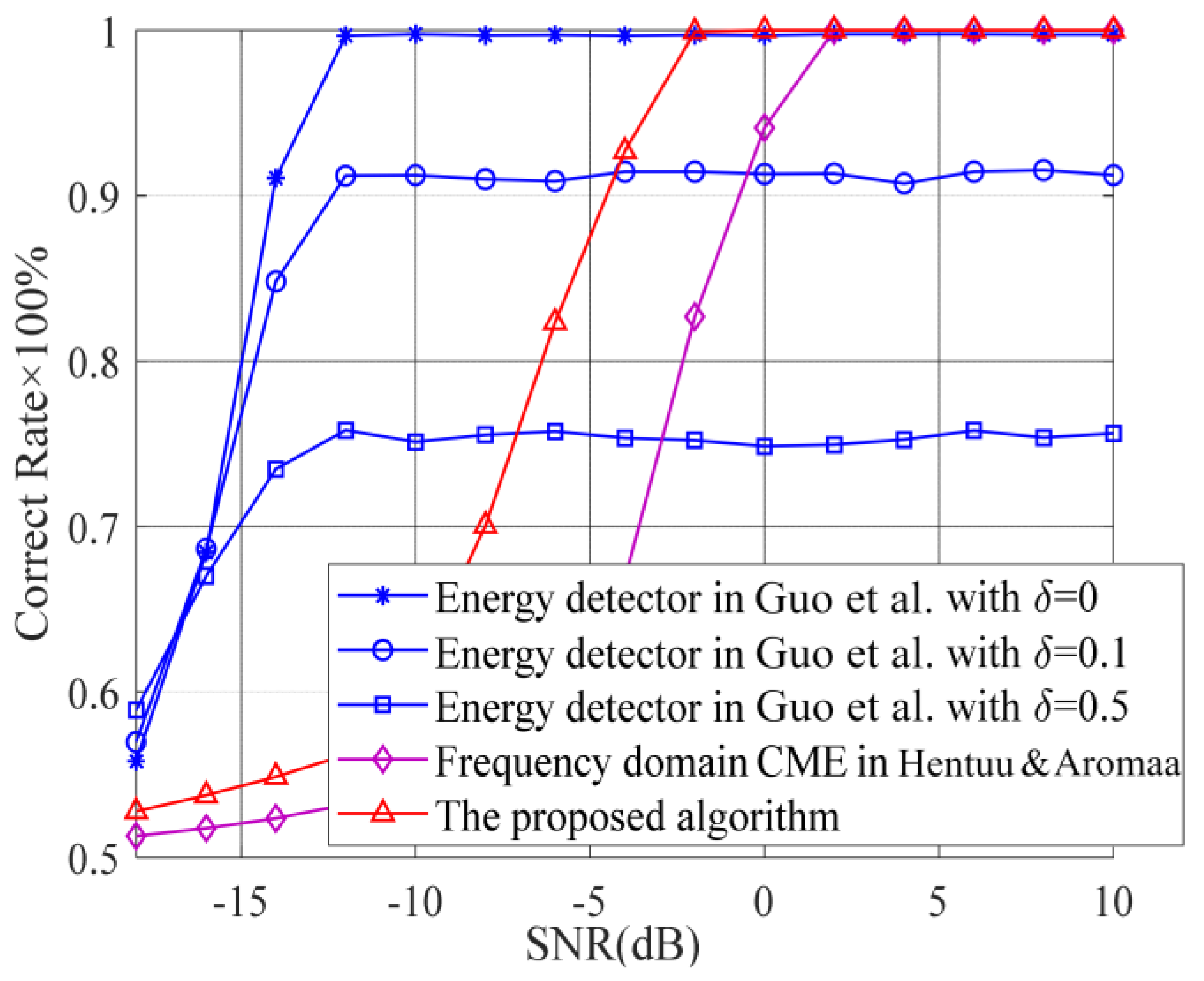
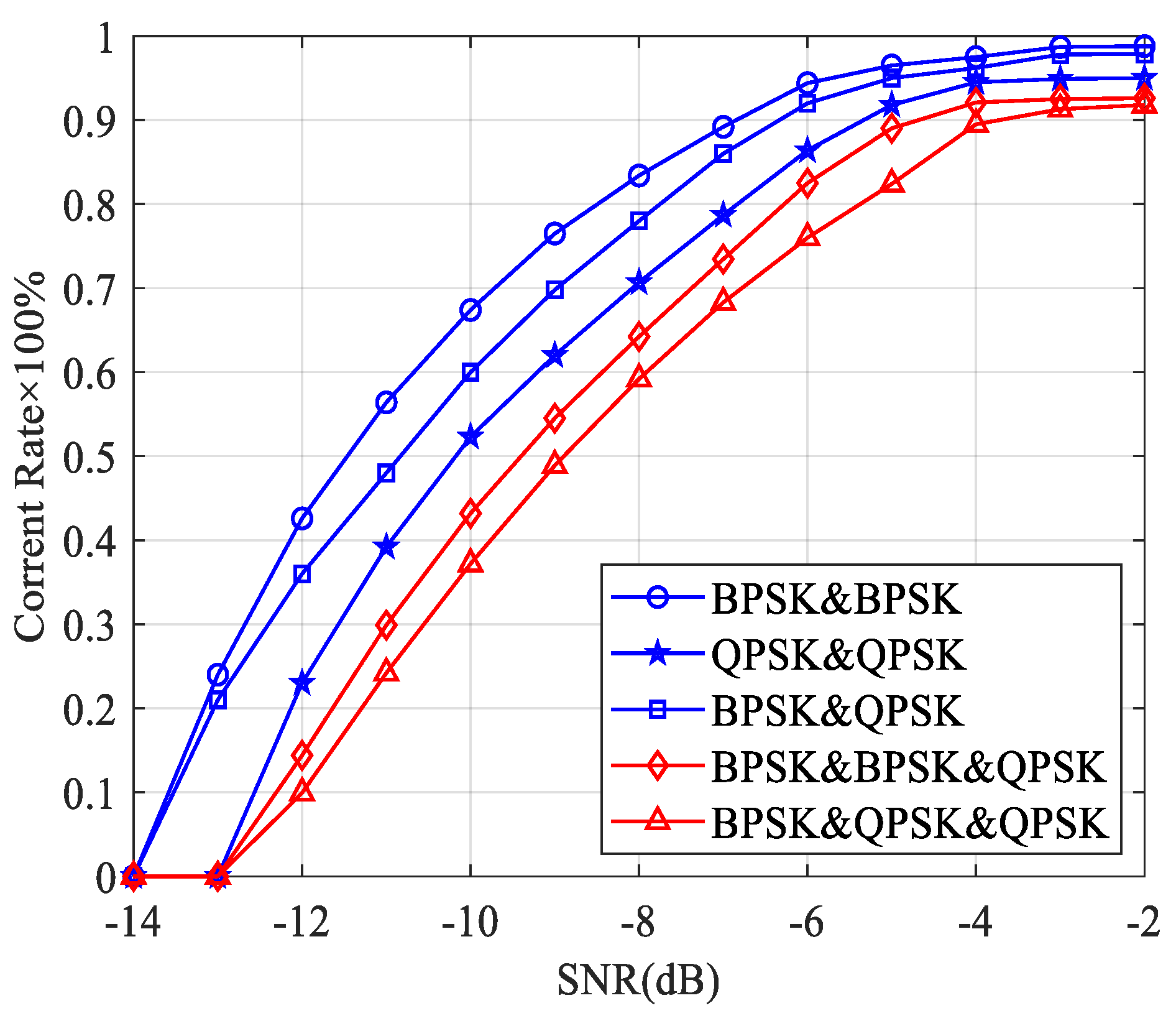

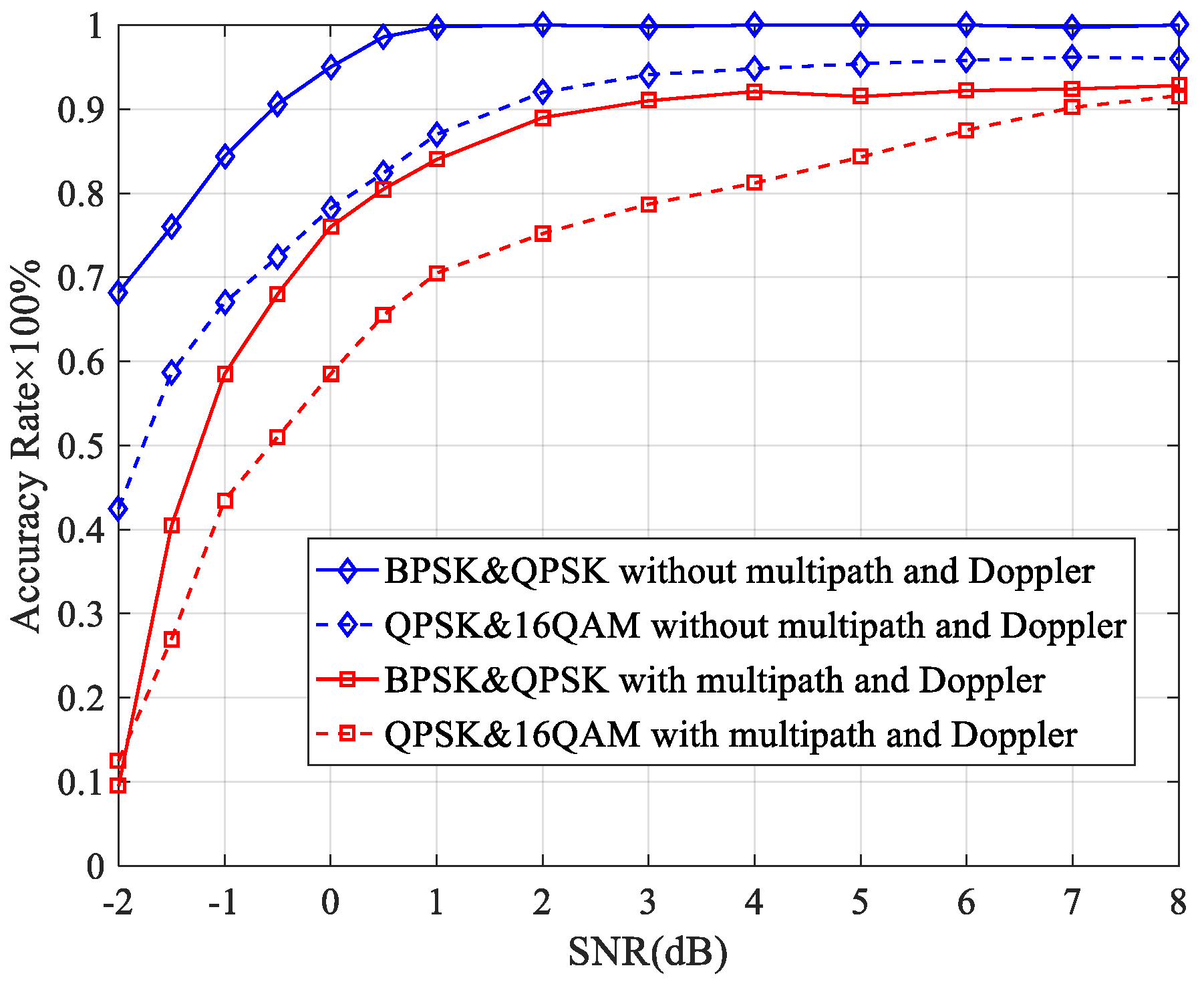
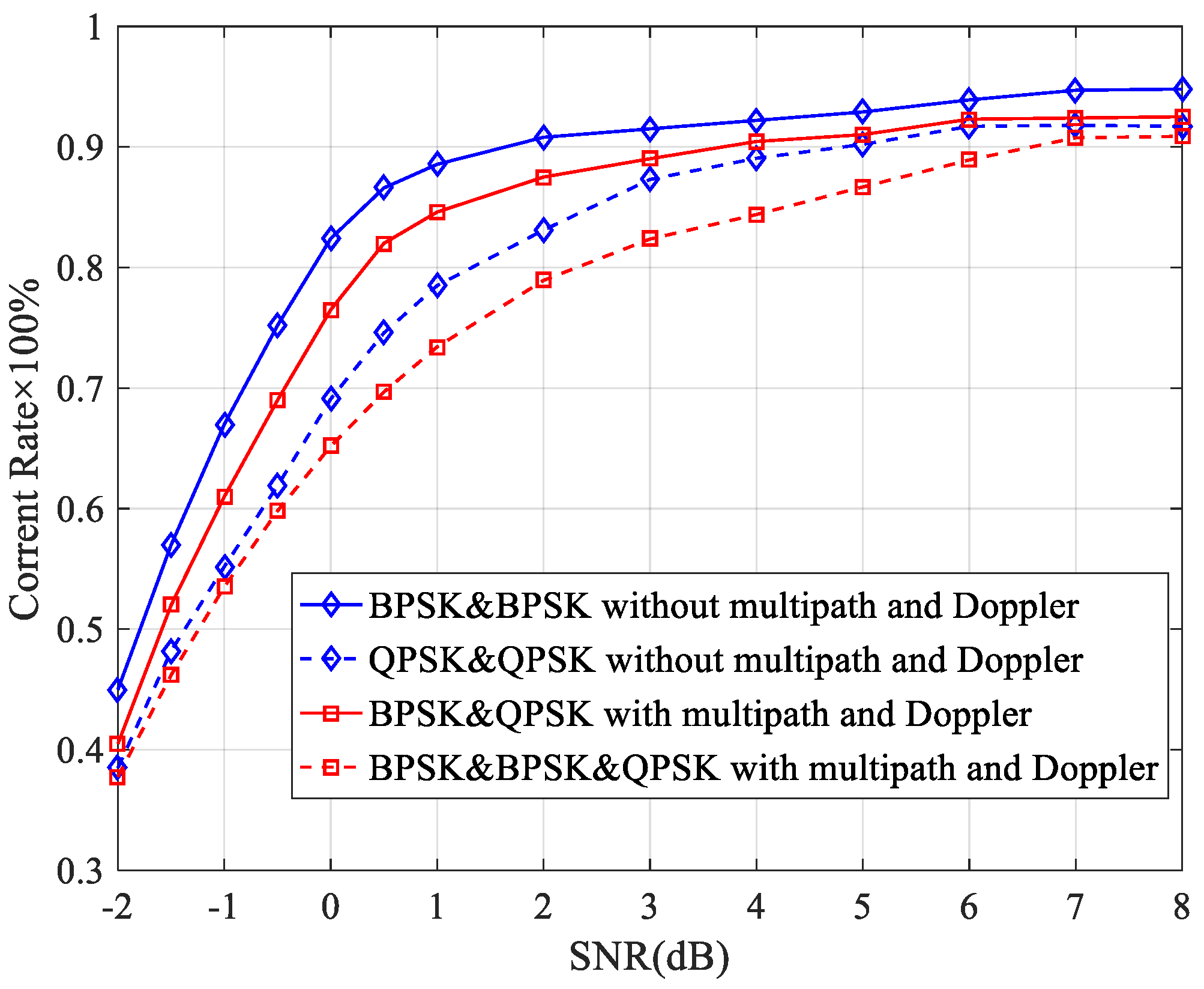
| Without Interference | With One BPSK Interference | With One QPSK Interference | |
|---|---|---|---|
| Expected signal is BPSK | |||
| Expected signal is QPSK | |||
| Expected signal is 16 QAM |
Disclaimer/Publisher’s Note: The statements, opinions and data contained in all publications are solely those of the individual author(s) and contributor(s) and not of MDPI and/or the editor(s). MDPI and/or the editor(s) disclaim responsibility for any injury to people or property resulting from any ideas, methods, instructions or products referred to in the content. |
© 2023 by the authors. Licensee MDPI, Basel, Switzerland. This article is an open access article distributed under the terms and conditions of the Creative Commons Attribution (CC BY) license (https://creativecommons.org/licenses/by/4.0/).
Share and Cite
Wang, P.; Yao, J.; Pu, Y.; Zhang, S.; Wen, L. Study of Interference Detection of Rail Transit Wireless Communication System Based on Fourth-Order Cyclic Cumulant. Sensors 2023, 23, 8291. https://doi.org/10.3390/s23198291
Wang P, Yao J, Pu Y, Zhang S, Wen L. Study of Interference Detection of Rail Transit Wireless Communication System Based on Fourth-Order Cyclic Cumulant. Sensors. 2023; 23(19):8291. https://doi.org/10.3390/s23198291
Chicago/Turabian StyleWang, Peng, Junliang Yao, Yong Pu, Shuyuan Zhang, and Lu Wen. 2023. "Study of Interference Detection of Rail Transit Wireless Communication System Based on Fourth-Order Cyclic Cumulant" Sensors 23, no. 19: 8291. https://doi.org/10.3390/s23198291
APA StyleWang, P., Yao, J., Pu, Y., Zhang, S., & Wen, L. (2023). Study of Interference Detection of Rail Transit Wireless Communication System Based on Fourth-Order Cyclic Cumulant. Sensors, 23(19), 8291. https://doi.org/10.3390/s23198291







